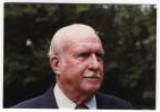
George Devol
Encyclopedia
George Charles Devol, Jr. (February 20, 1912 – August 11, 2011) was an American inventor who was awarded the patent for Unimate
, the first industrial robot
. Devol's patent for the first digitally operated programmable robotic arm represented the foundation of the modern robotics industry.
As an inventor he had over 40 patents and was president of Devol Research. Devol has resided in Fort Lauderdale, Florida
and Wilton, Connecticut
operating a robot consulting business.
in 1912, Devol was interested from boyhood in all things electrical and mechanical such as boats, airplanes, and engines.
He got some practical experience at Riordan Prep, where, in addition to studying traditional subjects, he helped construct some buildings and run the school's electric light plant. Although he wasn't very scholarly he read everything he could about mechanical devices, trying to discover what, besides building radios, could be done with vacuum tube
s when applied as control devices.
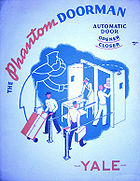 At that time, Devol asked himself "what else can we do with all these photocells and vacuum tubes?"
At that time, Devol asked himself "what else can we do with all these photocells and vacuum tubes?"
Devol decided that United Cinephone needed inventions in order to sell its photoelectric switches. One of Devol's first inventions was the automatic door. United Cinephone licensed Devol's invention to Yale & Towne who manufactured the "Phantom Doorman" photoelectric door. This was the first automatic opening door, now ubiquitous in grocery stores and elsewhere. United Cinephone also manufactured many of its own products using photoelectric cells and vacuum tube control systems. Among these was a very early bar code system that was used for sorting packages at the Railway Express Company, years before others would separately come up with similar technology.
 United Cinephone also manufactured Orthoplane lighting, another product Devol patented, for garment factories. United Cinephone also invented the first optical registration controls for color offset printing presses and packaging machinery. The company also manufactured phonograph arms and amplifiers. In fact, Devol installed amplifiers at the Cotton Club
United Cinephone also manufactured Orthoplane lighting, another product Devol patented, for garment factories. United Cinephone also invented the first optical registration controls for color offset printing presses and packaging machinery. The company also manufactured phonograph arms and amplifiers. In fact, Devol installed amplifiers at the Cotton Club
and enjoyed watching Count Basie
, Fred Waring
and others, occasionally taking in the after-hours jam sessions.
In 1939 United Cinephone installed automated photoelectric counters at New York World's Fair to count customers entering the fairgrounds.
Around the time the World War II
began, Devol sold his interest in United Cinephone and approached Sperry Gyroscope to see if they were interested in his ideas on radar technology. He was retained by Sperry as manager of the Special Projects Department that developed radar devices and microwave test equipment.
Later in the war, he approached Auto-Ordnance Company
regarding products that company could produce aside from their primary product line, which were Thompson submachine gun
s. Devol told them that the field of radar counter-measures was about to emerge as an urgently needed defense technology.
In 1943, he organized General Electronics Industries in Greenwich, Connecticut, as a subsidiary of the Auto Ordinance Corporation. General Electronics produced counter-radar devices until the end of the War. General Electronics was one of the largest producers of radar and radar counter-measure equipment for the U.S. Navy, U.S. Army Air Force and other government agencies. The company's radar counter-measure systems were on allied planes on D-Day.
Over a difference of opinion regarding the future of certain projects, Devol resigned from Auto Ordinance and joined RCA. After a short stint as eastern sales manager of electronics products, which he felt "wasn't his ball of wax", Devol left RCA to develop ideas that eventually led to the patent application for the first industrial robot. In 1946 he applied for a patent on a magnetic recording system for controlling machines and a digital playback device for machines.
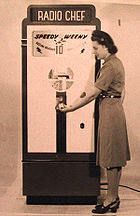 Devol was part of the team that developed the first commercial use of microwave oven technology, the Speedy Weeny, which automatically cooked and dispensed hotdogs in places such as Grand Central Terminal
Devol was part of the team that developed the first commercial use of microwave oven technology, the Speedy Weeny, which automatically cooked and dispensed hotdogs in places such as Grand Central Terminal
.
In the early 1950s, Devol licensed his digital magnetic recording device to Remington Rand of Norwalk, CT and became manager of their magnetics department. There he worked with a team to develop his magnetic recording system for business data applications. He also worked on developing the first high-speed printing systems. While the magnetic recording system proved too slow for business data, Devol's invention was re-purposed as a machine control that would eventually become the "brains" of the Unimate robot.
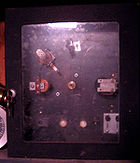 In the 1940s, Devol wasn't thinking about robots. Instead, he was focusing on manipulators and his patent on magnetic recording devices. He felt the world was ready for new ideas as he saw the introduction of automation into factories during this time.
In the 1940s, Devol wasn't thinking about robots. Instead, he was focusing on manipulators and his patent on magnetic recording devices. He felt the world was ready for new ideas as he saw the introduction of automation into factories during this time.
In 1954, Devol applied for patent on Programmed Article Transfer that introduced the concept of Universal Automation or Unimation; was issued in 1961. At the suggestion of Devol's wife, Evelyn, the word "Unimate" was coined to define the product, much the same as George Eastman
had coined Kodak.
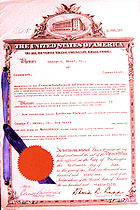 When he filed the patent for a programmable method for transferring articles, he wrote, "the present invention makes available for the first time a more or less general purpose machine that has universal application to a vast diversity of applications where cyclic digital control is desired." Devol's patent for the first digitally operated programmable robotic arm represents the foundation of the modern robotics industry.
When he filed the patent for a programmable method for transferring articles, he wrote, "the present invention makes available for the first time a more or less general purpose machine that has universal application to a vast diversity of applications where cyclic digital control is desired." Devol's patent for the first digitally operated programmable robotic arm represents the foundation of the modern robotics industry.
After applying for this seminal patent — which had not a single prior citation — Devol searched for a company willing to give him financial backing to develop his programmable articles transfer system. He talked with many major corporations in the United States
during his search. Through family connections, Devol obtained an audience with a partner in the firm Manning, Maxwell and Moore. Joseph F. Engelberger, at that time, was chief of engineering in the aircraft products division at Manning, Maxwell and Moore
in Stratford, Connecticut
. Engelberger was very interested, and Devol agreed to license Manning, Maxwell and Moore his patent and some future patents in the field. Just as this decision was being made, however, Dresser Industries bought Manning, Maxwell and Moore and didn't see the need for its aircraft division and its industrial robot patent licenses.
This development prompted Engelberger to seek a backer to buy out the aircraft division and found one in Consolidated Diesel Electronic (Condec), which agreed to put up the financing for the continued development of the robot. This new Condec division was called Unimation Incorporated with Joseph Engelberger
as its president.
The first Unimate prototypes were controlled by vacuum tubes used as digital switches though later versions used transistor
s. Further, the "off-the-shelf" parts available in the late 1950s, such as digital encoders, were not adequate for the Unimate's purpose, and as a result, with Devol's guidance and a team of skilled engineers, Unimation designed and machined practically every part in the first Unimates. They also invented a variety of new technologies, including a unique rotating drum memory
system with data parity controls.
In 1960, Devol personally sold the first Unimate
robot, which was shipped in 1961 from Danbury, Connecticut
to General Motors
. GM first used the machine for die casting
handling and spot welding
. The first Unimate robot was installed at GM's Inland Fisher Guide Plant
in Ewing Township, New Jersey
in 1961 to lift hot pieces of metal from a die-casting machine and stack them. Soon companies such as Chrysler
, Ford, and Fiat
saw the necessity for large Unimate purchases.
Approximately $5 million was spent to develop the first Unimate. In 1966, after many years of market surveys and field tests, full scale production began in Connecticut. Unimation's first production robot was a materials handling robot and was soon followed by robots for welding and other applications.
In 1975, Unimation showed its first profit. In 1978, the PUMA (Programmable Universal Machine for Assembly
) robot was developed by Unimation from Vicarm (Victor Scheinman
) and with support from General Motors.
In 2005, Popular Mechanics
magazine selected Devol's Unimate as one of the Top 50 Inventions of the Past 50 Years.
Unimate
Unimate was the first industrial robot,which worked on a General Motors assembly line at the Inland Fisher Guide Plant in Ewing Township, New Jersey, in 1961.It was created by George Devol in the 1950s using his original patents...
, the first industrial robot
Industrial robot
An industrial robot is defined by ISO as an automatically controlled, reprogrammable, multipurpose manipulator programmable in three or more axes...
. Devol's patent for the first digitally operated programmable robotic arm represented the foundation of the modern robotics industry.
As an inventor he had over 40 patents and was president of Devol Research. Devol has resided in Fort Lauderdale, Florida
Fort Lauderdale, Florida
Fort Lauderdale is a city in the U.S. state of Florida, on the Atlantic coast. It is the county seat of Broward County. As of the 2010 census, the city had a population of 165,521. It is a principal city of the South Florida metropolitan area, which was home to 5,564,635 people at the 2010...
and Wilton, Connecticut
Wilton, Connecticut
Wilton is a town nestled in the Norwalk River Valley in southwestern Connecticut in the United States. It is located in Fairfield County. As of the 2010 census, the town population was 18,062. In 2007, it was voted as one of CNN Money's "Best Places to Live" in the United States.Located along...
operating a robot consulting business.
Biography
Born in Louisville, KentuckyLouisville, Kentucky
Louisville is the largest city in the U.S. state of Kentucky, and the county seat of Jefferson County. Since 2003, the city's borders have been coterminous with those of the county because of a city-county merger. The city's population at the 2010 census was 741,096...
in 1912, Devol was interested from boyhood in all things electrical and mechanical such as boats, airplanes, and engines.
He got some practical experience at Riordan Prep, where, in addition to studying traditional subjects, he helped construct some buildings and run the school's electric light plant. Although he wasn't very scholarly he read everything he could about mechanical devices, trying to discover what, besides building radios, could be done with vacuum tube
Vacuum tube
In electronics, a vacuum tube, electron tube , or thermionic valve , reduced to simply "tube" or "valve" in everyday parlance, is a device that relies on the flow of electric current through a vacuum...
s when applied as control devices.
United Cinephone
Choosing to forego higher education, in 1932 Devol went into business, forming United Cinephone to produce variable area recording directly onto film for the new sound motion pictures ("talkies"). However, he later learned that companies like RCA and Western Electric were working in the same area, and decided to discontinue the product.
Devol decided that United Cinephone needed inventions in order to sell its photoelectric switches. One of Devol's first inventions was the automatic door. United Cinephone licensed Devol's invention to Yale & Towne who manufactured the "Phantom Doorman" photoelectric door. This was the first automatic opening door, now ubiquitous in grocery stores and elsewhere. United Cinephone also manufactured many of its own products using photoelectric cells and vacuum tube control systems. Among these was a very early bar code system that was used for sorting packages at the Railway Express Company, years before others would separately come up with similar technology.

Cotton Club
The Cotton Club was a famous night club in Harlem, New York City that operated during Prohibition that included jazz music. While the club featured many of the greatest African American entertainers of the era, such as Fletcher Henderson, Duke Ellington, Adelaide Hall, Count Basie, Bessie Smith,...
and enjoyed watching Count Basie
Count Basie
William "Count" Basie was an American jazz pianist, organist, bandleader, and composer. Basie led his jazz orchestra almost continuously for nearly 50 years...
, Fred Waring
Fred Waring
Fredrick Malcolm Waring was a popular musician, bandleader and radio-television personality, sometimes referred to as "America's Singing Master" and "The Man Who Taught America How to Sing." He was also a promoter, financial backer and namesake of the Waring Blendor, the first modern electric...
and others, occasionally taking in the after-hours jam sessions.
In 1939 United Cinephone installed automated photoelectric counters at New York World's Fair to count customers entering the fairgrounds.
World War II
In 1939, Devol applied for a patent for proximity controls for use in laundry press machines, based on a radio frequency field. This control would automatically open and close laundry presses when workers approached the machines. Once the war began, Devol was advised by the patent office that his patent application would be placed on hold for the duration of the conflict.Around the time the World War II
World War II
World War II, or the Second World War , was a global conflict lasting from 1939 to 1945, involving most of the world's nations—including all of the great powers—eventually forming two opposing military alliances: the Allies and the Axis...
began, Devol sold his interest in United Cinephone and approached Sperry Gyroscope to see if they were interested in his ideas on radar technology. He was retained by Sperry as manager of the Special Projects Department that developed radar devices and microwave test equipment.
Later in the war, he approached Auto-Ordnance Company
Auto-Ordnance Company
Auto-Ordnance was a U.S. arms development firm founded by retired Colonel John T. Thompson of the U.S. Army Ordnance Department in 1916. Auto-Ordnance is best known for the Thompson submachine gun, notorious as a gangster weapon of the Roaring Twenties and famous as a military weapon of the Allied...
regarding products that company could produce aside from their primary product line, which were Thompson submachine gun
Thompson submachine gun
The Thompson is an American submachine gun, invented by John T. Thompson in 1919, that became infamous during the Prohibition era. It was a common sight in the media of the time, being used by both law enforcement officers and criminals...
s. Devol told them that the field of radar counter-measures was about to emerge as an urgently needed defense technology.
In 1943, he organized General Electronics Industries in Greenwich, Connecticut, as a subsidiary of the Auto Ordinance Corporation. General Electronics produced counter-radar devices until the end of the War. General Electronics was one of the largest producers of radar and radar counter-measure equipment for the U.S. Navy, U.S. Army Air Force and other government agencies. The company's radar counter-measure systems were on allied planes on D-Day.
Over a difference of opinion regarding the future of certain projects, Devol resigned from Auto Ordinance and joined RCA. After a short stint as eastern sales manager of electronics products, which he felt "wasn't his ball of wax", Devol left RCA to develop ideas that eventually led to the patent application for the first industrial robot. In 1946 he applied for a patent on a magnetic recording system for controlling machines and a digital playback device for machines.
Other post-war work

Grand Central Terminal
Grand Central Terminal —often incorrectly called Grand Central Station, or shortened to simply Grand Central—is a terminal station at 42nd Street and Park Avenue in Midtown Manhattan in New York City, United States...
.
In the early 1950s, Devol licensed his digital magnetic recording device to Remington Rand of Norwalk, CT and became manager of their magnetics department. There he worked with a team to develop his magnetic recording system for business data applications. He also worked on developing the first high-speed printing systems. While the magnetic recording system proved too slow for business data, Devol's invention was re-purposed as a machine control that would eventually become the "brains" of the Unimate robot.
The first industrial robot: Unimate

In 1954, Devol applied for patent on Programmed Article Transfer that introduced the concept of Universal Automation or Unimation; was issued in 1961. At the suggestion of Devol's wife, Evelyn, the word "Unimate" was coined to define the product, much the same as George Eastman
George Eastman
George Eastman was an American innovator and entrepreneur who founded the Eastman Kodak Company and invented roll film, helping to bring photography to the mainstream...
had coined Kodak.

After applying for this seminal patent — which had not a single prior citation — Devol searched for a company willing to give him financial backing to develop his programmable articles transfer system. He talked with many major corporations in the United States
United States
The United States of America is a federal constitutional republic comprising fifty states and a federal district...
during his search. Through family connections, Devol obtained an audience with a partner in the firm Manning, Maxwell and Moore. Joseph F. Engelberger, at that time, was chief of engineering in the aircraft products division at Manning, Maxwell and Moore
Manning, Maxwell and Moore
Manning, Maxwell and Moore was a Bridgeport, Connecticut railroad supply company created by Charles Arthur Moore....
in Stratford, Connecticut
Stratford, Connecticut
Stratford is a town in Fairfield County, Connecticut, United States, located on Long Island Sound at the mouth of the Housatonic River. It was founded by Puritans in 1639....
. Engelberger was very interested, and Devol agreed to license Manning, Maxwell and Moore his patent and some future patents in the field. Just as this decision was being made, however, Dresser Industries bought Manning, Maxwell and Moore and didn't see the need for its aircraft division and its industrial robot patent licenses.
This development prompted Engelberger to seek a backer to buy out the aircraft division and found one in Consolidated Diesel Electronic (Condec), which agreed to put up the financing for the continued development of the robot. This new Condec division was called Unimation Incorporated with Joseph Engelberger
Joseph Engelberger
Joseph F. Engelberger is a physicist, engineer and entrepreneur who is referred to as the "Father of Robotics". Licensing the original patent awarded to inventor George Devol, Engelberger developed the first industrial robot in the United States, the Unimate, in the 1950s...
as its president.
The first Unimate prototypes were controlled by vacuum tubes used as digital switches though later versions used transistor
Transistor
A transistor is a semiconductor device used to amplify and switch electronic signals and power. It is composed of a semiconductor material with at least three terminals for connection to an external circuit. A voltage or current applied to one pair of the transistor's terminals changes the current...
s. Further, the "off-the-shelf" parts available in the late 1950s, such as digital encoders, were not adequate for the Unimate's purpose, and as a result, with Devol's guidance and a team of skilled engineers, Unimation designed and machined practically every part in the first Unimates. They also invented a variety of new technologies, including a unique rotating drum memory
Drum memory
Drum memory is a magnetic data storage device and was an early form of computer memory widely used in the 1950s and into the 1960s, invented by Gustav Tauschek in 1932 in Austria....
system with data parity controls.
In 1960, Devol personally sold the first Unimate
Unimate
Unimate was the first industrial robot,which worked on a General Motors assembly line at the Inland Fisher Guide Plant in Ewing Township, New Jersey, in 1961.It was created by George Devol in the 1950s using his original patents...
robot, which was shipped in 1961 from Danbury, Connecticut
Danbury, Connecticut
Danbury is a city in northern Fairfield County, Connecticut, United States. It had population at the 2010 census of 80,893. Danbury is the fourth largest city in Fairfield County and is the seventh largest city in Connecticut....
to General Motors
General Motors
General Motors Company , commonly known as GM, formerly incorporated as General Motors Corporation, is an American multinational automotive corporation headquartered in Detroit, Michigan and the world's second-largest automaker in 2010...
. GM first used the machine for die casting
Die casting
Die casting is a metal casting process that is characterized by forcing molten metal under high pressure into a mold cavity. The mold cavity is created using two hardened tool steel dies which have been machined into shape and work similarly to an injection mold during the process...
handling and spot welding
Spot welding
Spot welding is a process in which contacting metal surfaces are joined by the heat obtained from resistance to electric current flow. Work-pieces are held together under pressure exerted by electrodes. Typically the sheets are in the thickness range...
. The first Unimate robot was installed at GM's Inland Fisher Guide Plant
Inland Fisher Guide Plant (New Jersey)
The Inland Fisher Guide Plant was a General Motors facility located in the West Trenton section of Ewing Township, New Jersey that opened in 1938 as one of its most modern plants and was operated by the firm for 60 years...
in Ewing Township, New Jersey
Ewing Township, New Jersey
-Demographics:As of the 2010 Census, there were 35,790 people, 13,171 households, and 7,980 families residing in the township. There were 13,926 housing units. The racial makeup of the township was 63.1% White, 27.6% African American, 0.3% Native American, 4.3% Asian, 0.0% Pacific Islander, 2.2%...
in 1961 to lift hot pieces of metal from a die-casting machine and stack them. Soon companies such as Chrysler
Chrysler
Chrysler Group LLC is a multinational automaker headquartered in Auburn Hills, Michigan, USA. Chrysler was first organized as the Chrysler Corporation in 1925....
, Ford, and Fiat
Fiat
FIAT, an acronym for Fabbrica Italiana Automobili Torino , is an Italian automobile manufacturer, engine manufacturer, financial, and industrial group based in Turin in the Italian region of Piedmont. Fiat was founded in 1899 by a group of investors including Giovanni Agnelli...
saw the necessity for large Unimate purchases.
Approximately $5 million was spent to develop the first Unimate. In 1966, after many years of market surveys and field tests, full scale production began in Connecticut. Unimation's first production robot was a materials handling robot and was soon followed by robots for welding and other applications.
In 1975, Unimation showed its first profit. In 1978, the PUMA (Programmable Universal Machine for Assembly
Programmable Universal Machine for Assembly
The PUMA is an industrial robot arm developed by Victor Scheinman at pioneering robot company Unimation...
) robot was developed by Unimation from Vicarm (Victor Scheinman
Victor Scheinman
Victor Scheinman is a pioneer in the field of robotics. He is a graduate of the now-defunct New Lincoln High School in New York. In the late 1950s, and while in high school, Scheinman engineered a speech-to-text machine as a science fair project...
) and with support from General Motors.
In 2005, Popular Mechanics
Popular Mechanics
Popular Mechanics is an American magazine first published January 11, 1902 by H. H. Windsor, and has been owned since 1958 by the Hearst Corporation...
magazine selected Devol's Unimate as one of the Top 50 Inventions of the Past 50 Years.
Additional work
Devol later obtained patents on visual and tactile sensors for robots, coaxial connectors, non-refillable containers, and magnetostrictive manipulators or "microrobotics", a field he created.- Elected to honorary member of the Society of Manufacturing EngineersSociety of Manufacturing EngineersThe Society of Manufacturing Engineers is a non-profit organization.-History of the Society:Founded in 1932 with 33 members, the organization was originally named The Society of Tool Engineers . A year later, it was renamed the American Society of Tool Engineers...
(1985) - Inducted into the National Inventor's Hall of Fame (2011)
- Member of the Automation Hall of Fame
- Henry Ford and Smithsonian Museum collections both include UnimateUnimateUnimate was the first industrial robot,which worked on a General Motors assembly line at the Inland Fisher Guide Plant in Ewing Township, New Jersey, in 1961.It was created by George Devol in the 1950s using his original patents...
robots

